Photo of the Week
New photos are posted weekly. If you are interesting in submitting a photo for the Photo of the Week please contact me.
'Like' Global Jaunt on facebook to see more photos and post your own!
July 8th 2012
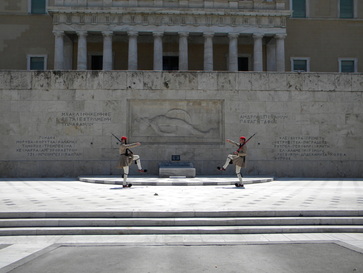
David Weger explains his photo:
Amidst all the Media coverage of the economic issues facing Greece, one can be assured that all of the National Treasures that we have come to expect from a visit to Greece will be open and accessible. Having visited Greece for the first time last month, we enjoyed, without any concerns, running around Athens on our own for a couple of days before our guided tour began. In Athens I would highly recommend the New Acropolis Museum (before visiting The Acropolis), the Acropolis, and the Plaka (the markets of lower town below the Acropolis - fun, but mostly as a place to browse vs buy).
With respect this picture, I have watched the Changing of the Guard at Buckingham Palace and in Canada, but I have never seen anything as unusual this. I cannot begin to describe it, but would highly encourage any of you that have the opportunity to visit Athens to take 30 minutes and stand and watch the Palace Guards. You won't be disappointed.
Amidst all the Media coverage of the economic issues facing Greece, one can be assured that all of the National Treasures that we have come to expect from a visit to Greece will be open and accessible. Having visited Greece for the first time last month, we enjoyed, without any concerns, running around Athens on our own for a couple of days before our guided tour began. In Athens I would highly recommend the New Acropolis Museum (before visiting The Acropolis), the Acropolis, and the Plaka (the markets of lower town below the Acropolis - fun, but mostly as a place to browse vs buy).
With respect this picture, I have watched the Changing of the Guard at Buckingham Palace and in Canada, but I have never seen anything as unusual this. I cannot begin to describe it, but would highly encourage any of you that have the opportunity to visit Athens to take 30 minutes and stand and watch the Palace Guards. You won't be disappointed.
July 1st 2012

Although Paris is the most famous love lock bridge, I have seen a half dozen of them this summer. Lover purchase a lock and engrave (or write with a marker) their names. it is then locked to the bridge to cement their relationship for eternity. Ironically, many of these bridges get so many locks on them that most of the locks are cut off on a yearly basis.
I have seen love lock bridges in Paris, Berlin, and Hamburg. This photo was taken in Prague. Fans of the show 'The Bachelorette' may recognize it as the locale of one of Emily's dates during the summer 2012 season.
I have seen love lock bridges in Paris, Berlin, and Hamburg. This photo was taken in Prague. Fans of the show 'The Bachelorette' may recognize it as the locale of one of Emily's dates during the summer 2012 season.
June 24th 2012
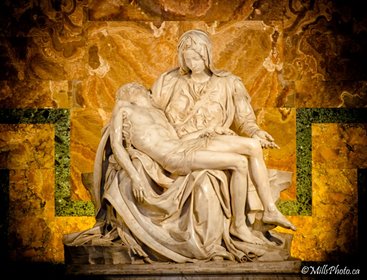
Rick Millette runs a photography business in Ottawa. He took the following photo on a European vacation. Here is his commentary on the shot:
"Some nut job took a hammer to it in 1971 so now it's in-cased in glass. Mary had lost her nose! Some people stopped the nut job and others took pieces of the statue. To get all the pieces back, the Pope announced 'if you don't return the pieces you took, you will go to hell'. All the pieces were returned! ".
See more of his work at http://millsphoto.ca
"Some nut job took a hammer to it in 1971 so now it's in-cased in glass. Mary had lost her nose! Some people stopped the nut job and others took pieces of the statue. To get all the pieces back, the Pope announced 'if you don't return the pieces you took, you will go to hell'. All the pieces were returned! ".
See more of his work at http://millsphoto.ca
June 17th 2012
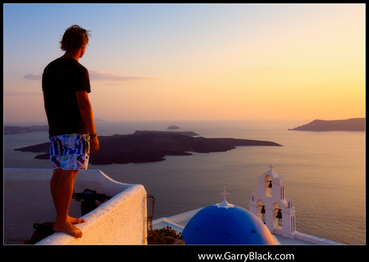
GARRY BLACK is, for the most part, a self-taught photographer. That meant a lot of trial and error and that was back in the days of film, which unfortunately he wasted lots of. He had started photography as a hobby, but in 1986, he decided to devote his time and energy to photography on a full time basis. He had discovered that with photography he had found a medium that enabled him to express his creative abilities. He has been teaching photographic workshops since 1984 and today is regarded as one of Canada's leading creative photographers as well as one of the top selling stock photographers.
See more of his work at http://www.garryblack.com/.
See more of his work at http://www.garryblack.com/.
June 10th 2012
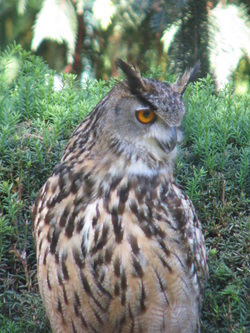
Owls are such gorgeous birds! This beauty was spotted in the Czech Republic.
I think he saw something that he wanted to eat...
I think he saw something that he wanted to eat...
June 3rd 2012
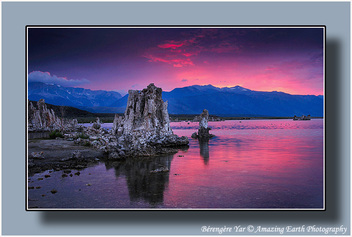
Submitted by Bérengère Yar
As a landscape photographer, I have the opportunity to visit a lot of different places and to discover plenty of amazing places. Mono Lake is one of my favorite. It is an alkaline and hypersaline lake in California. In order to provide resources for the growing Los Angeles area, water was diverted from the Owens River in the 1940s. An aqueduct system was extended into the Mono Basin, the surface level of Mono Lake fell rapidly. By 1982 the lake was reduced to 37,688 acres; a 31% loss in surface area. As a result alkaline sands and once-submerged tufa towers became exposed. Now, Mono Lake is protected. The lake contains approximately 280 million tons of dissolved salts, with the salinity varying on the amount of water in the lake at any given time. The hypersalinity and high alkalinity means that no fish are native to the lake. The lake is famous for the Mono Lake brine shrimp, Artemia monica, a tiny species of brine shrimp, no bigger than a thumbnail, that are found nowhere else on earth. Mono Lake is also a vital resting and eating stop for migratory shorebirds. Nearly 2,000,000 waterbirds, including 35 species of shorebirds, use Mono Lake to rest and eat for at least part of the year.
May 27th 2012
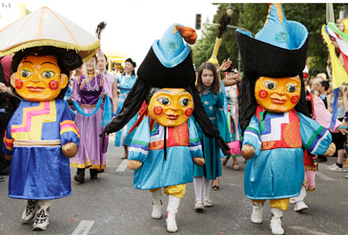
Every summer, Berlin celebrates its own unique carnival, called the Carnival of Cultures - more than 1,5 million visitors flock here to celebrate the multicultural spirit of Germany’s capital.
Berlin is home to more than 450,000 people from around the world and proud to be the most international city in Germany. The Carnival of Cultures pays tribute to Berlin’s ethnic diversity and the peaceful coexistence of its different cultures with this fun summer festival.
Berlin is home to more than 450,000 people from around the world and proud to be the most international city in Germany. The Carnival of Cultures pays tribute to Berlin’s ethnic diversity and the peaceful coexistence of its different cultures with this fun summer festival.
May 20th 2012

Leopards are one of my favourite animals. I am enamoured with wild cats of all types, but leopards hold a special place in my heart. Maybe it is because they are so elusive and hard to find?
Leopards spend the majority of their non-hunting time in trees. They are very secretive animals, so little is known about them in comparison to other wild cats. With the exception of mothers with their young, leopards tend to be solitary creatures, so the only thing more lucky then seeing one leopard is two!
Leopards spend the majority of their non-hunting time in trees. They are very secretive animals, so little is known about them in comparison to other wild cats. With the exception of mothers with their young, leopards tend to be solitary creatures, so the only thing more lucky then seeing one leopard is two!
May 13th 2012
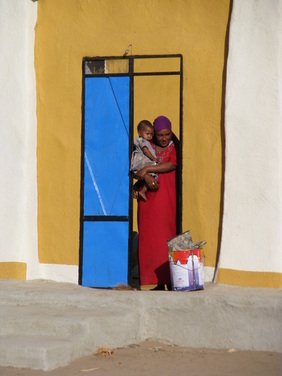
Happy Mother's Day!
This photo is doubly appropriate. Not only is it of a mother in Sudan, but it also is my mother's favorite photo out of my collection.
Happy Mother's Day to my mom. You are a very special and important person to me. Thank you for everything that you do for me.
This photo is doubly appropriate. Not only is it of a mother in Sudan, but it also is my mother's favorite photo out of my collection.
Happy Mother's Day to my mom. You are a very special and important person to me. Thank you for everything that you do for me.
May 6th 2012
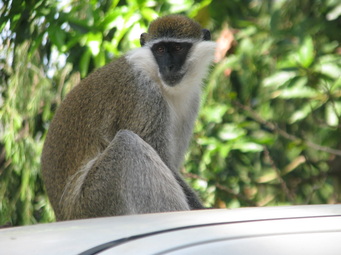
There are monkeys everywhere in the bush camps near the Bale Mountains in Ethiopia. They sit on the cars, they play on the tends, and the steal everything. Nothing is safe! A member of my group even had a bottle of soda stolen right out of his hand by these cunning creatures!
April 29th 2012
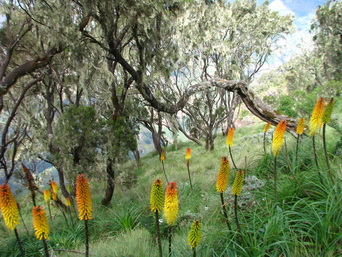
This photo is of 'fire poker flowers'. The photo was taken in the Bale Mountains National Park. The vibrant colors of the plant were beautiful, especially against the lush green background. This photo is the typical scenery that one sees while in the Ethiopian highlands.
April 22nd 2012
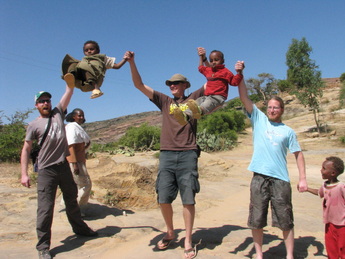
When visiting Ethiopia, it is evident that aid and tourism has had an enormous effect on the younger generations. Kids run out of their houses when we pass. They try to grab our hands when we walk in town. The smiling faces and waves are adorable. The pleas for "bic?" "plastic?", and "money?" get very old, very fast. As our local guide pointed out to us, the children who are out flirting with the foreigners are skipping school or ignoring their family's animals (Ethiopian farm children [80% of the population are farmers] receive ten animals to take care at age four).
Get to know the children, but do not destroy their future.
Get to know the children, but do not destroy their future.
April 15th 2012
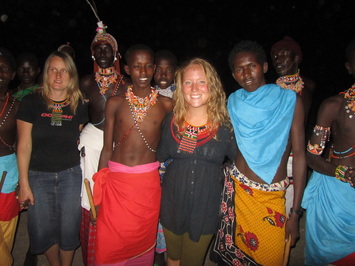
The Samburo tribe are nomadic people who are polygamous; having many wives and children. Half the children care for animals, and half go to school. Woman marry at age 14 and men raise animals until they are 15-17 years old at which time they are circumcised. They mustn't cry, blink, or show any signs of pain. If they succeed they are covered in elaborate beads created by their mothers and sisters. This is a sign that they are now men. Until the age of the 30 the men are warriors, who protect the village. They are not allowed to eat inside the village and must hunt all of their own food with other warriors. After the age of 30 their parents choose a wife for them and they are married. Any additional wives are chosen by the man.
April 8th 2012
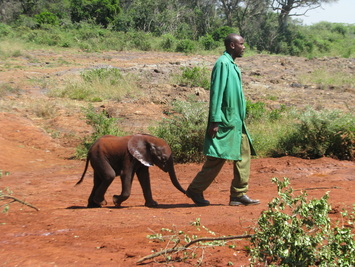
The rescue team from the David Sheldrick Wildlife Trust are an amazing people who rescue orphaned animals throughout Kenya and nurse them back to health. The center is unique in the way that they hand-raise the animals. Elephants are taken care of by a team of dedicated keepers, who attend to their needs. They live together, creating a ‘family’, not unlike the one the elephants lost. The youngest elephant living in the center during my visit was 4 weeks old.
April 1st 2012
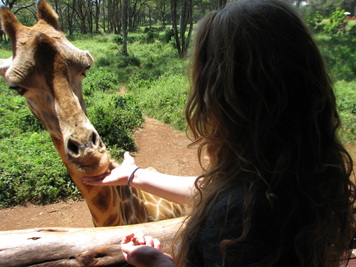
The Giraffe Center in Nairobi, Kenya is the home of a conservation project focusing on the endangered Roschild Giraffe. The giraffes have a large compound, with a small viewing platform open to humans. The giraffes come over to be pet and fed pellets when they want to. One of the giraffes, Kelly, licked me on the face, twice!
March 25th 2012
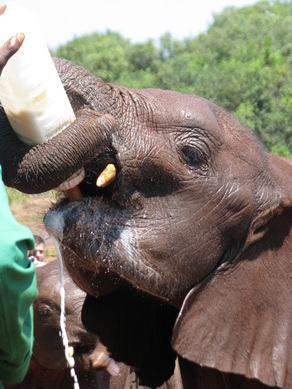
The David Sheldrick Wildlife Trust allows visitors to have the opportunity to meet the orphan elephants in their care. For one hour a day, visitors can watch a feeding of the elephants. This is a really special opportunity, as the elephants are particularly playful animals. It is amazing to watch the orphans play, eat, and interact with each other and the keepers. On my visit to the center one of the elephants came very close to the crowd. I had the opportunity to touch his back. He felt surprisingly greasy, which is a stark contrast to their dry-looking skin. The visit truly was the opportunity of a lifetime.
Click here to visit the website of the David Sheldrick Wildlife Trust.
Click here to visit the website of the David Sheldrick Wildlife Trust.
March 18th 2012
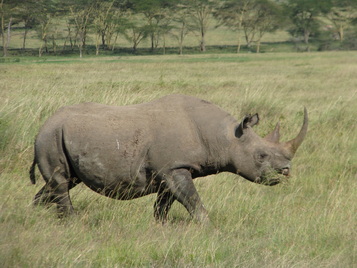
Poaching is a vile activity that is decimating the populations of many different species of animals. I chose this photo to represent the plight of the Northern White Rhino, which can be read about here.
March 11th 2012
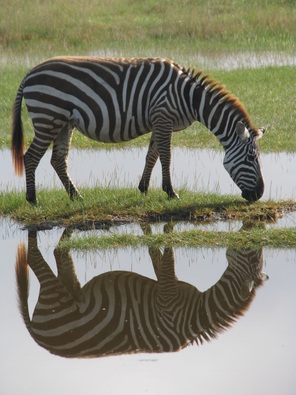
This is one of my favorite photos! The photo was taken in the Nakuru National Park in Kenya. This zebra was enjoying his dinner when he passed by a pool of water. I seized the moment to capture the photo which, to me, represents the beauty of nature.
March 4th 2012
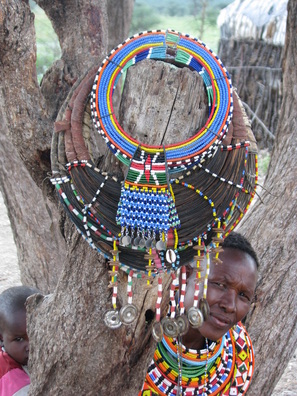
When we arrived at the Hamar tribe we quickly realized that we were in for a real treat; there was a coming of age ceremony going on. This is the moment when a boy becomes a man and is entitled to get married. The boy has to get completely naked and jump over a half dozen bulls. However, this is getting off easy, as the women in his life are whipped mercilessly, to indicate their love for him. The deep scars and bleeding gashes of the women walking around helped to prove that this was no tourist show, but something that has been going on for centuries in this little part of the world. It was a shocking, amazing, and unforgettable experience.
February 26th 2012
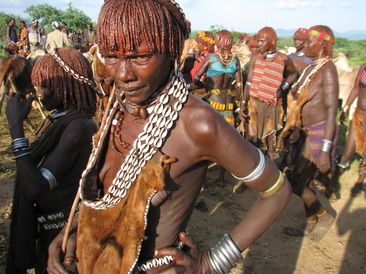
I had the opportunity to take a tour of tribal Ethiopia, which started at the tribal market in The Banna Village. The market is an opportunity for members of the Banna and Hammar tribes to exchange goods with each other. Although there were a few small items that could be bought for souvenirs, most items were food, produce, and clothing. This was no tourist market, rather the 'real deal'. The women had tightly plaited hair that was covered in reddish-brown mud. Most of them wore goat skin skirts that were long in the back and short in the front. Many of the men were wearing miniskirts with painted arms and legs. Everyone had numerous bangles on their bodies.
February 19th 2012
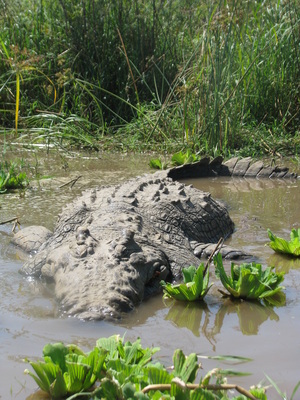
Lake Chamo is located in Southern Ethiopia. River cruises in a motorboat allow for the chance to see hippopotamuses and Nile crocodiles. This giant is one of these crocs!
February 12th 2012
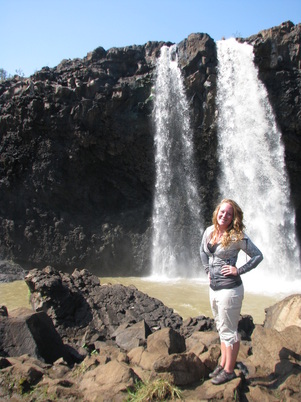
The Blue Nile Falls is not the highest, widest, or most dramatic waterfall I've seen, but it is still a wonder of nature.We got right up close to the falls, sitting right in the spray. We all commented that in the developed world there would have been a fence a few dozen meters back from our vantage point. A few of our strongest swimmers went skinny-dipping under the falls. I have a feeling that wouldn't have been allowed in North America either...
February 5th 2012
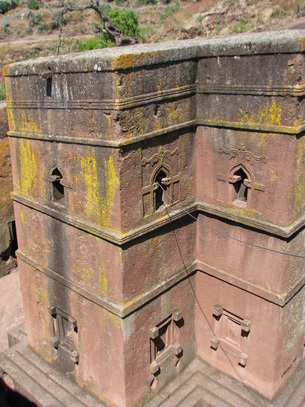
Lalibela is located in northern Ethiopia. The town is famous for the rock hewn churches which are carved into the ground. It is known as the holiest city in Ethiopia. The churches are still used today. The interiors are quite sparse, but the outside of the churches are extremely elaborate. It is shocking to think of how much time it must have taken to construct them all.
January 29th 2012
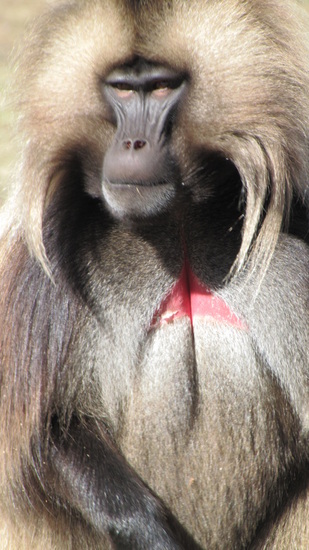
Guides and scouts are mandatory for anyone who wants go into the Simien Mountains National Park. The scouts speak very little English and carry rusty World War era guns. The guns are carried supposedly to protect us from the leopards, who went extinct in the park several years ago. The truth is that it is an attempt to create jobs for locals using the park; I can certainly support that, although I wish that it didn't involve a man with a gun sitting next to me on a bumpy road.
We saw the bleeding heart baboons almost right away. There are thousands of them, in groups of 10- 100 along the roads. They are the only grass eating species of monkey in the world. One baboon eats 1kg of grass a day. They are disliked by the people who are still living in the park as they also eat crops and fields meant for livestock.
We saw the bleeding heart baboons almost right away. There are thousands of them, in groups of 10- 100 along the roads. They are the only grass eating species of monkey in the world. One baboon eats 1kg of grass a day. They are disliked by the people who are still living in the park as they also eat crops and fields meant for livestock.
January 22nd 2012
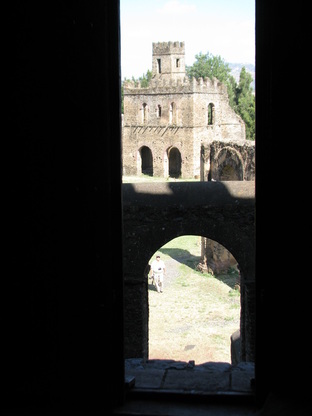
Gondor is known as the 'Camelot of Africa' due to the massive number of royal quarters. The castles and green scenery are gorgeous!
January 15th 2012
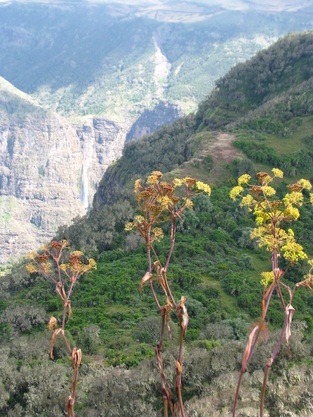
Things change dramatically, almost ironically so, when you cross the border between Sudan and Ethiopia. Gone are the sand dunes, replaced by grassy hills and bare bottomed children.
I'm really not sure what I was expecting from Ethiopia. The main images we receive in the West are the 'famine in the Horn of Africa' type, which skew how most people perceive this country. I know I wasn't expecting a country so lush it could be a Caribbean island (or the Irish countryside, as one of my fellow travelers insists that it looks like). This really is quite a cool place!
I'm really not sure what I was expecting from Ethiopia. The main images we receive in the West are the 'famine in the Horn of Africa' type, which skew how most people perceive this country. I know I wasn't expecting a country so lush it could be a Caribbean island (or the Irish countryside, as one of my fellow travelers insists that it looks like). This really is quite a cool place!
January 8th 2012

Sufi dancing shows are a popular form of entertainment for tourists in many companies. While in Sudan I wanted to go and see one of these shows. I heard that a show happened weekly in Khartoum, so a taxi was hired to drive there. It was supposed to be a stage show put on by the whirling dervish dancers. Our request got lost in translation and we were brought to a church where the Sufis pray on Friday nights. We were the only white faces in the crowd, as everyone else was there to pray. The Sulfis wore extravagant outfits and danced while chanting.
In essence, we saved the price of admission and got to see the authentic Sufi dancing, rather than a choreographed dance; what good luck!
In essence, we saved the price of admission and got to see the authentic Sufi dancing, rather than a choreographed dance; what good luck!
January 1st 2012
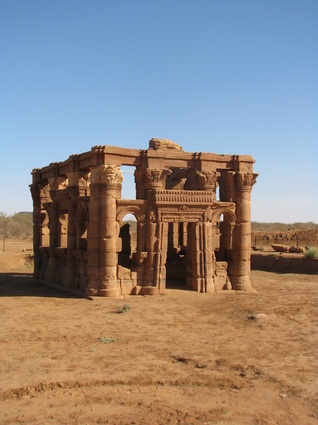
This beautiful building is known as the Naga Temple. It is in the middle of the desert, with nothing else nearby. According to our guide, the temple is devoted to a lion god. The shocking thing is that it is in great condition. This is confusing as there is no entry fee and no evidence that anyone is taking care of the site. Yet, somehow, it is still in amazing shape!
December 25th 2011
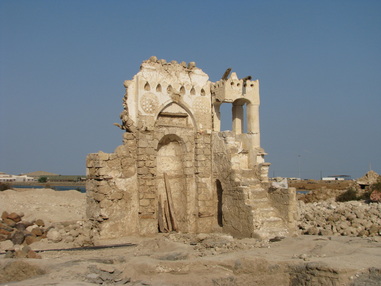
Near the town of Port Sudan is the small town of Saukin. The only real landmark of this town in an old port town. It is on a small island. It was abandoned for unknown reasons between the Egyptian rule and the Roman rule. The entire town was made out of coral. It was mostly demolished, but there were many laborers working to try and rebuild the site, one colored block at a time.
December 18th 2011
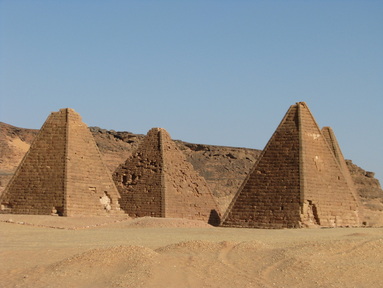
The Monroe Pyramids are the most famous in Sudan. They are smaller than the Egyptian ones, but there are more of them. A long time ago an Italian man paid the Sudanese Government in order to have excavation rights to the area. He got bored of the slow progress traditional methods were providing him, so he bought some dynamite. He did find a few treasures, however he also succeeded in blowing most of the pyramids up. There was an attempt at reconstruction in 1979, but the work is very conspicuous.
December 11th 2011
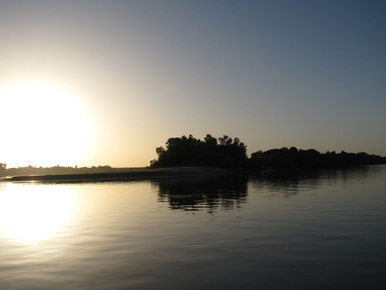
I had the opportunity to visit Sudan just after the country split into two countries. This view is of a river in North Sudan, outside of Wadi Halfa. I bush camped at this location.
December 4th 2011
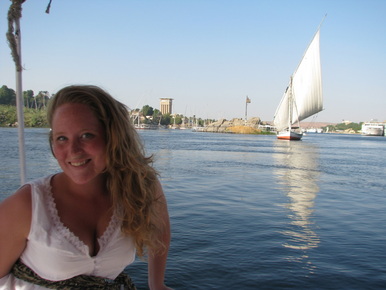
The felucca is a traditional sailing boat that still dominates the Nile's boating scene. These wooden boats move smoothly down the Nile, allowing for a more relaxing trip than with a motorboat.
November 27th 2011
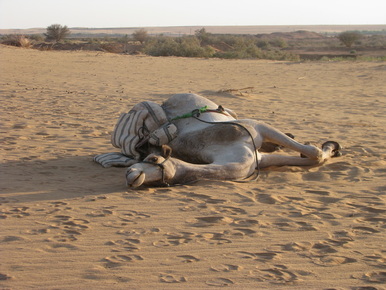
Camels have a reputation for being mean. I took a camel ride with a herd of 30. Mounting up on the camel was surprisingly frightening. The way they stand up makes you feel like you are going to be pitched off the front, then pitched off the back, before you settle in the middle.
The baby camels are dainty and sweet.They keep close by, often rubbing up against their parents (and therefore the riders). After a short time I ceased being surprised when a baby came nibbling on my pants. Overall, they did not live up to their mean reputation. They seemed more interested in licking us than spitting.
The baby camels are dainty and sweet.They keep close by, often rubbing up against their parents (and therefore the riders). After a short time I ceased being surprised when a baby came nibbling on my pants. Overall, they did not live up to their mean reputation. They seemed more interested in licking us than spitting.
November 20th 2011

The white desert is stunning. There is no the way to describe it. It comes out nowhere, the landscape changing from rocky sand to white chalky stones. My favorite area is the mushroom shaped protrusions that stand erect in the ground.
I bush camped in this area, setting up our tents and cooking supplies in the middle of the desert. It was a beautiful place to spend a night.
I bush camped in this area, setting up our tents and cooking supplies in the middle of the desert. It was a beautiful place to spend a night.
November 13th 2011
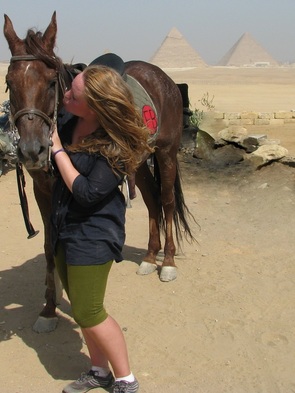
The typical first look at the pyramids is just after passing a Taco Bell, in a plaza, filled with toutes and other tourists. I had the opportunity to experience a more special 'first moment'.
FB stables is a one of the few stables on the street that has horses which did not have their bones protruding. They were clearly well cared for and were in great shape. They carried us across the desert. These were not your typical walk in a line horses. They wanted nothing more than to run around the desert at a gallop. And they sure did! It was exhilarating!
We rode out of Cairo passing close by the pyramids. It was the ideal first glance at them. After an afternoon of riding our legs hurt terribly!
FB stables is a one of the few stables on the street that has horses which did not have their bones protruding. They were clearly well cared for and were in great shape. They carried us across the desert. These were not your typical walk in a line horses. They wanted nothing more than to run around the desert at a gallop. And they sure did! It was exhilarating!
We rode out of Cairo passing close by the pyramids. It was the ideal first glance at them. After an afternoon of riding our legs hurt terribly!
November 6th 2011
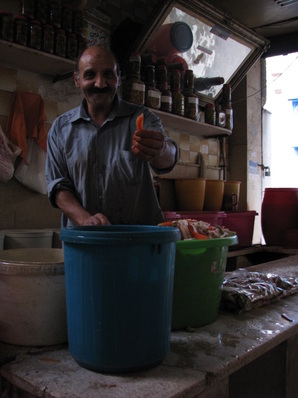
The Kali al-Kalili market is considered by many to be the best market in Cairo. It is divided into several sections, including a tourist market, local market and spice market. We decided to go the more authentic route and hired a guide to take us through the local Egyptian market.
We traveled through the market, acquiring various souvenirs as we moved along. The local market (more casually known as the Egyptian Market) is where the items are hand crafted for sale in the tourist markets. It was very cool to see the creation process of many popular souvenirs.
During our tour we also visited a pickling factory and a bakery. This photo is of a pickler in the market. However, the most interesting stop of all was to a printing press. Walking around the room I came to the realization of what the pages being printed and stacked around me were. There was no mistaking the Koran. Now, that's an experience not many people can say they have had while shopping!
We traveled through the market, acquiring various souvenirs as we moved along. The local market (more casually known as the Egyptian Market) is where the items are hand crafted for sale in the tourist markets. It was very cool to see the creation process of many popular souvenirs.
During our tour we also visited a pickling factory and a bakery. This photo is of a pickler in the market. However, the most interesting stop of all was to a printing press. Walking around the room I came to the realization of what the pages being printed and stacked around me were. There was no mistaking the Koran. Now, that's an experience not many people can say they have had while shopping!
October 30th 2011
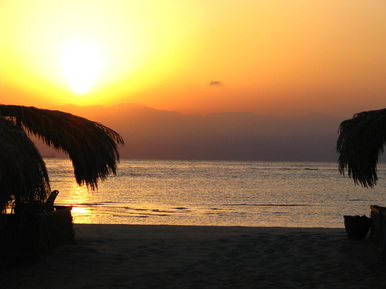
The Red Sea is a body of water situated between Egypt and Saudi Arabia. Although it borders other countries, it was at this point that I visited the Red Sea.Although the Red Sea has a maximum depth of 2211 meters, there are many areas which are significantly shallower. The waters bordering the resort that I spent time at were quite shallow. There was a coral reef, which was quite beautiful to visit. Although the reef is becoming increasingly bleached, there was still a great variety of fish.
October 23rd 2011
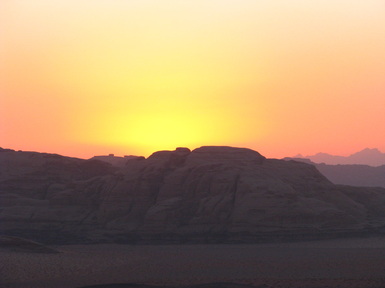
Wadi Rum is a desert located in the south of Jordan. Unlike most deserts, it features hilly projections which reach heights of up to 5900 feet (Mount Um Dami isthe tallest).
Inhabitation of the area is indicated by the graffiti, both new and ancient. A group of Bedouin people still inhabit the area, providing touristic trips for visitors. Many people take 4x4 trips and camp overnight in the desert.
Wadi Rum has been used as a setting for many different films. The most famous of which are 'Lawrence of Arabia', 'Red Planet', and 'Transformers: Revenge of the Fallen'.
Inhabitation of the area is indicated by the graffiti, both new and ancient. A group of Bedouin people still inhabit the area, providing touristic trips for visitors. Many people take 4x4 trips and camp overnight in the desert.
Wadi Rum has been used as a setting for many different films. The most famous of which are 'Lawrence of Arabia', 'Red Planet', and 'Transformers: Revenge of the Fallen'.
October 16th 2011
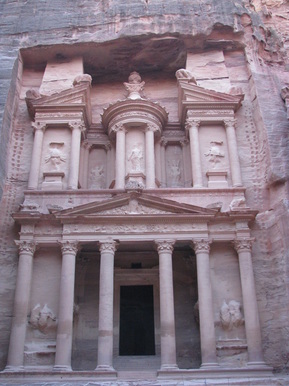
I had the chance to visit Petra during the Arab Spring, which provided me the amazing opportunity to visit Petra with practically no other tourists present. Petra has been a UNESCO World Heritage Site since 1985. This protection allows for the continued excavation and restoration. This photo is of the treasury building, which is the most iconic place in Petra. The famous rock hewn building is a misnomer, as it never actually held treasure. Petra has been awarded the 'Top 40 Places to Visit Before You Die' by BBC and the 'New 7 Wonders of the World'.
October 9th 2011
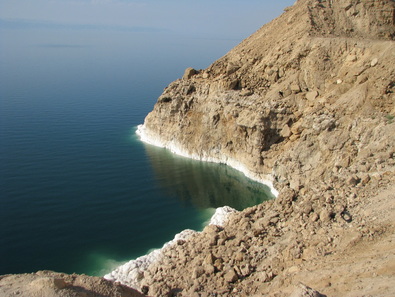
The Dead Sea is the lowest point on earth. Some areas of the shore are as low as 1400 meters below sea level. However, the Dead Sea is shrinking. Year after year the average water level is decreasing. This is primarily due to the surrounding countries taking water out of the Dead Dead for their own uses. Some scientists predict that the Dead Sea will be empty by 2050. Although there are projects under way to try and prevent this from happening, for now, the evidence is visible. Layers of salt line the rocks, showing where the waterline once was.
October 2nd 2011
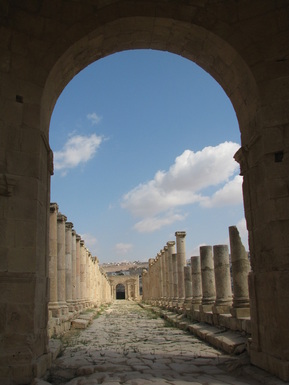
Located in the north of Jordan is the ancient city of Jerash. The city has been continuously inhabited for 6,500 years. However, the old city was badly damaged by an earthquake. Over the last 70 years the site has been excavated and restored. The beautiful architecture made for an incredible view.
September 25th 2011
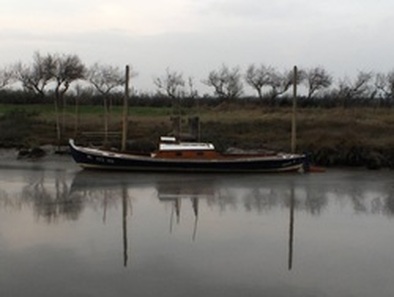
Welcome to the first week of Global Jaunt! To celebrate I will be posting my favorite photos from trips gone by.
This photo was taken at the Port of Andernos, which is situated on the Bassin D'Arcachon. This small boat is a traditional fishing boat called a 'Pinasse'. They were historically used by fishermen and oyster farmers.
This photo was taken at the Port of Andernos, which is situated on the Bassin D'Arcachon. This small boat is a traditional fishing boat called a 'Pinasse'. They were historically used by fishermen and oyster farmers.
